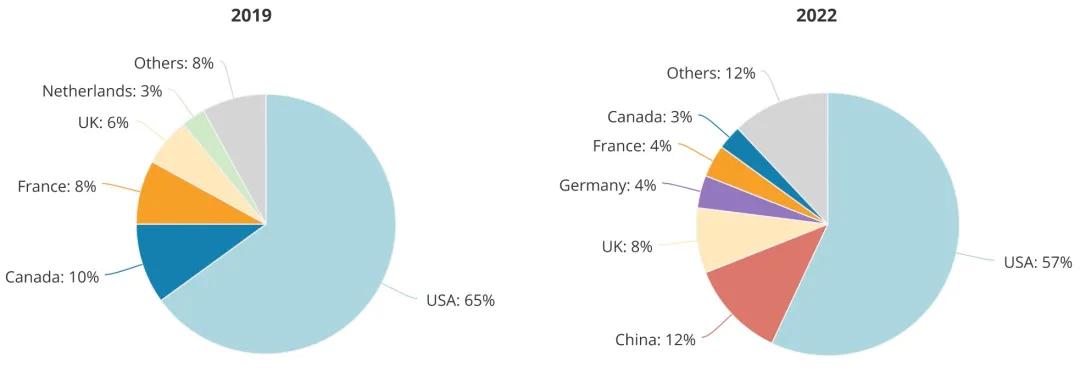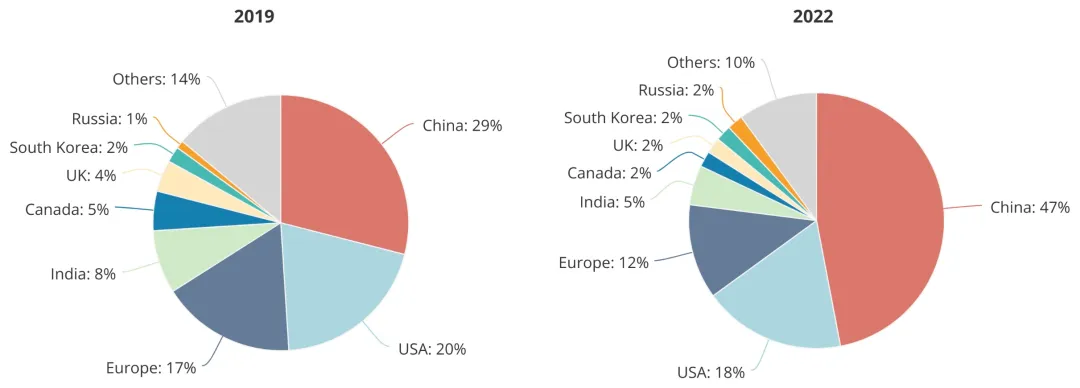 Technology peripherals
Technology peripherals
 AI
AI
 Top AI researchers, China contributes 26%: Global Talent Think Tank report released
Top AI researchers, China contributes 26%: Global Talent Think Tank report released
Top AI researchers, China contributes 26%: Global Talent Think Tank report released
In 2019, "MIT Technology Review" reported a report on the growth rate of China's artificial intelligence talent pool. The main findings of the report are very interesting: In the past decade, the number of elite artificial intelligence scholars from China has increased tenfold, but relatively few people stay in China to work.
This week, a report revealed new analysis from the think tank behind it, showing how the makeup of the global AI talent pool has changed since then – during this critical period. The artificial intelligence industry has undergone a major transformation and has become the hottest technology field.

Artificial intelligence (AI) has penetrated into every corner of the world. The rapid development of large-scale language models and machine learning methods, as well as the amazing improvements in computing hardware, have increased the capabilities of artificial intelligence to the level of "promoting a new round of industrial revolution."
It can be foreseen that a large amount of capital and talents in the technology community will be used to implement artificial intelligence applications. Competition among countries in the field of AI will be more intense than ever, and much of the competition will revolve around an indispensable input to the AI ecosystem: talent.
The "Global Artificial Intelligence Talent Tracking Survey Report 2.0" released by the MacroPolo think tank under the Paulson Institute (Paulson Institute) in the United States clarifies the top Global distribution and mobility of artificial intelligence researchers and scientists.
In order to make an apples-to-apples comparison, this 2023 updated version (2.0), like the 1.0 version, uses NeurIPS, the top conference in the field of artificial intelligence, as a sample. At the December 2022 meeting, NeurIPS accepted a record 2671 papers, an acceptance rate of 25.6%, compared with 1428 papers in 2019, an acceptance rate of 21.6%.
Judging from the number of participants, submission scale and popularity, NeurIPS is one of the most representative artificial intelligence conferences, which also means that it is very suitable for Analyzing the top (top 20%) artificial intelligence research talent. We chose to focus on top talent because we believe top talent are most likely to play a leading role in research breakthroughs and establishing new applications in commercial fields.
"Global Artificial Intelligence Talent Tracking Survey Report 2.0" covers the following points:
In the United States, intelligent talents are still the first choice for top talents destination. Among U.S. institutions, U.S. and Chinese researchers (based on undergraduate degrees) account for 75% of top talent in intelligence, up from 58% in 2019. Additionally, the U.S. remains the leading workplace for elite AI talent (top 2%) and hosts 60% of top AI institutions.
2. In addition to the United States and China, the United Kingdom and South Korea, as well as Europe, have slightly increased their share as work destinations for top artificial intelligence researchers. In terms of sources of artificial intelligence researchers (based on undergraduate degrees), India and Canada have seen a relative decline.
3. China has expanded its AI talent pool in the past few years to meet the growing demand for AI industry. With China producing a significant proportion of the world’s top AI researchers (rising from 29% in 2019 to 47% in 2022), it’s no surprise that more Chinese talent is working in domestic industries.
4. A similar situation seems to be happening in India. While India remains a significant exporter of top AI researchers, its ability to retain talent is growing. In 2019, almost all Indian AI researchers (based on undergraduate degree) chose to pursue opportunities abroad. But by 2022, one in five Indian AI researchers ended up working in India.
5. These trends in China and India appear to reflect a broader pattern over the past few years: Top AI researchers have generally shown lower mobility. In 2022, only 42% of top AI researchers are foreigners currently working in other countries, down 13 percentage points from 2019, meaning more of the top talent will stay in their home countries.
The report uses 8 charts to intuitively and clearly describe the career development paths of top artificial intelligence researchers.
1. Where the most elite AI researchers (top ~2%) choose to work:

"The most elite artificial intelligence researchers" are defined here as the authors of papers selected for NeurIPS oral presentations, representing the most prestigious paper category. The acceptance rate for oral presentations in 2022 is 1.8%.
2. Primary countries of origin of the most elite AI researchers (top 2%, based on undergraduate degree)

It can be seen that the number of top AI talents in China and the United States is now very close.
3. Top 25 top artificial intelligence research institutions

It can be seen that Tsinghua University and Peking University have Entered the top ten.
4. Top countries of origin of top AI researchers (top 20%) working at U.S. institutions

The combined proportion of Chinese and American researchers is larger than in the past, accounting for 75% in total.
5. Country of origin of top AI researchers (top 20%, based on undergraduate degree)

6. The country where the top researchers (top 20%) currently work are headquartered:

It can be seen that the current United States Institutions and companies are still the main destination for talent, but China and Europe are becoming more attractive.
7. The ratio of some top artificial intelligence researchers (top 20%) working abroad to staying at home

8. After completing their PhDs in the United States, the vast majority of non-American artificial intelligence talents stay in the United States

This number is very intuitive : Nearly 80% of scholars studying for doctoral degrees in the United States will stay and work in the United States. In addition, the report also pointed out that 90% of AI-related professional scholars who graduated in China will stay in China.
It can be seen that in terms of training and introduction of AI talents, the United States still attracts the most talents with an overwhelming advantage, but China is catching up.
The above is the detailed content of Top AI researchers, China contributes 26%: Global Talent Think Tank report released. For more information, please follow other related articles on the PHP Chinese website!

Hot AI Tools

Undresser.AI Undress
AI-powered app for creating realistic nude photos

AI Clothes Remover
Online AI tool for removing clothes from photos.

Undress AI Tool
Undress images for free

Clothoff.io
AI clothes remover

AI Hentai Generator
Generate AI Hentai for free.

Hot Article

Hot Tools

Notepad++7.3.1
Easy-to-use and free code editor

SublimeText3 Chinese version
Chinese version, very easy to use

Zend Studio 13.0.1
Powerful PHP integrated development environment

Dreamweaver CS6
Visual web development tools

SublimeText3 Mac version
God-level code editing software (SublimeText3)

Hot Topics
 1377
1377
 52
52
 phpmyadmin creates data table
Apr 10, 2025 pm 11:00 PM
phpmyadmin creates data table
Apr 10, 2025 pm 11:00 PM
To create a data table using phpMyAdmin, the following steps are essential: Connect to the database and click the New tab. Name the table and select the storage engine (InnoDB recommended). Add column details by clicking the Add Column button, including column name, data type, whether to allow null values, and other properties. Select one or more columns as primary keys. Click the Save button to create tables and columns.
 How to create an oracle database How to create an oracle database
Apr 11, 2025 pm 02:33 PM
How to create an oracle database How to create an oracle database
Apr 11, 2025 pm 02:33 PM
Creating an Oracle database is not easy, you need to understand the underlying mechanism. 1. You need to understand the concepts of database and Oracle DBMS; 2. Master the core concepts such as SID, CDB (container database), PDB (pluggable database); 3. Use SQL*Plus to create CDB, and then create PDB, you need to specify parameters such as size, number of data files, and paths; 4. Advanced applications need to adjust the character set, memory and other parameters, and perform performance tuning; 5. Pay attention to disk space, permissions and parameter settings, and continuously monitor and optimize database performance. Only by mastering it skillfully requires continuous practice can you truly understand the creation and management of Oracle databases.
 How to create oracle database How to create oracle database
Apr 11, 2025 pm 02:36 PM
How to create oracle database How to create oracle database
Apr 11, 2025 pm 02:36 PM
To create an Oracle database, the common method is to use the dbca graphical tool. The steps are as follows: 1. Use the dbca tool to set the dbName to specify the database name; 2. Set sysPassword and systemPassword to strong passwords; 3. Set characterSet and nationalCharacterSet to AL32UTF8; 4. Set memorySize and tablespaceSize to adjust according to actual needs; 5. Specify the logFile path. Advanced methods are created manually using SQL commands, but are more complex and prone to errors. Pay attention to password strength, character set selection, tablespace size and memory
 How to write oracle database statements
Apr 11, 2025 pm 02:42 PM
How to write oracle database statements
Apr 11, 2025 pm 02:42 PM
The core of Oracle SQL statements is SELECT, INSERT, UPDATE and DELETE, as well as the flexible application of various clauses. It is crucial to understand the execution mechanism behind the statement, such as index optimization. Advanced usages include subqueries, connection queries, analysis functions, and PL/SQL. Common errors include syntax errors, performance issues, and data consistency issues. Performance optimization best practices involve using appropriate indexes, avoiding SELECT *, optimizing WHERE clauses, and using bound variables. Mastering Oracle SQL requires practice, including code writing, debugging, thinking and understanding the underlying mechanisms.
 How to add, modify and delete MySQL data table field operation guide
Apr 11, 2025 pm 05:42 PM
How to add, modify and delete MySQL data table field operation guide
Apr 11, 2025 pm 05:42 PM
Field operation guide in MySQL: Add, modify, and delete fields. Add field: ALTER TABLE table_name ADD column_name data_type [NOT NULL] [DEFAULT default_value] [PRIMARY KEY] [AUTO_INCREMENT] Modify field: ALTER TABLE table_name MODIFY column_name data_type [NOT NULL] [DEFAULT default_value] [PRIMARY KEY]
 Detailed explanation of nested query instances in MySQL database
Apr 11, 2025 pm 05:48 PM
Detailed explanation of nested query instances in MySQL database
Apr 11, 2025 pm 05:48 PM
Nested queries are a way to include another query in one query. They are mainly used to retrieve data that meets complex conditions, associate multiple tables, and calculate summary values or statistical information. Examples include finding employees above average wages, finding orders for a specific category, and calculating the total order volume for each product. When writing nested queries, you need to follow: write subqueries, write their results to outer queries (referenced with alias or AS clauses), and optimize query performance (using indexes).
 What are the integrity constraints of oracle database tables?
Apr 11, 2025 pm 03:42 PM
What are the integrity constraints of oracle database tables?
Apr 11, 2025 pm 03:42 PM
The integrity constraints of Oracle databases can ensure data accuracy, including: NOT NULL: null values are prohibited; UNIQUE: guarantee uniqueness, allowing a single NULL value; PRIMARY KEY: primary key constraint, strengthen UNIQUE, and prohibit NULL values; FOREIGN KEY: maintain relationships between tables, foreign keys refer to primary table primary keys; CHECK: limit column values according to conditions.
 What does oracle do
Apr 11, 2025 pm 06:06 PM
What does oracle do
Apr 11, 2025 pm 06:06 PM
Oracle is the world's largest database management system (DBMS) software company. Its main products include the following functions: relational database management system (Oracle database) development tools (Oracle APEX, Oracle Visual Builder) middleware (Oracle WebLogic Server, Oracle SOA Suite) cloud service (Oracle Cloud Infrastructure) analysis and business intelligence (Oracle Analytics Cloud, Oracle Essbase) blockchain (Oracle Blockchain Pla



